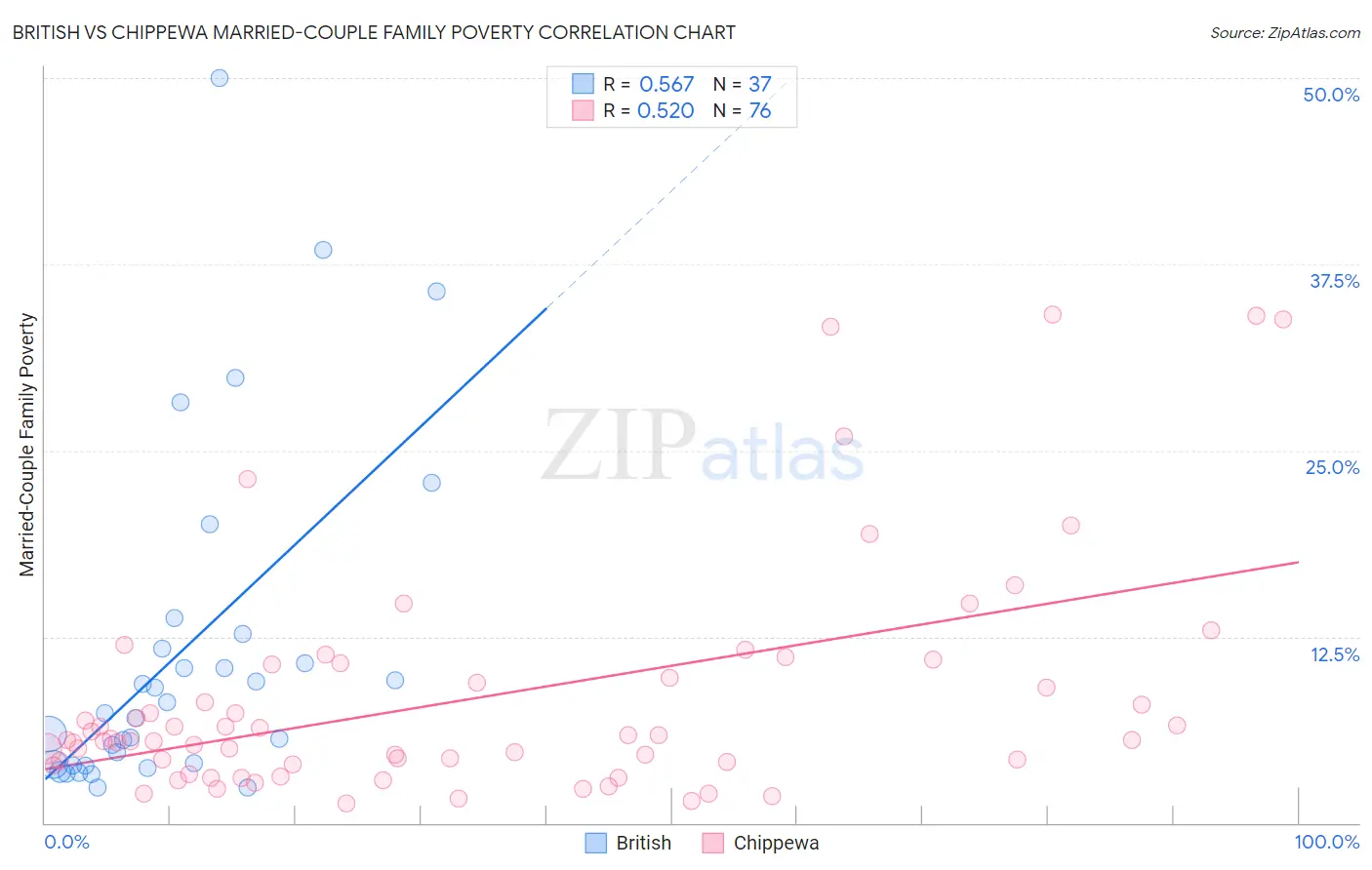British vs Chippewa Married-Couple Family Poverty
COMPARE
British
Chippewa
Married-Couple Family Poverty
Married-Couple Family Poverty Comparison
British
Chippewa
4.3%
MARRIED-COUPLE FAMILY POVERTY
99.8/ 100
METRIC RATING
46th/ 347
METRIC RANK
5.4%
MARRIED-COUPLE FAMILY POVERTY
18.9/ 100
METRIC RATING
205th/ 347
METRIC RANK
British vs Chippewa Married-Couple Family Poverty Correlation Chart
The statistical analysis conducted on geographies consisting of 521,525,466 people shows a substantial positive correlation between the proportion of British and poverty level among married-couple families in the United States with a correlation coefficient (R) of 0.567 and weighted average of 4.3%. Similarly, the statistical analysis conducted on geographies consisting of 213,662,644 people shows a substantial positive correlation between the proportion of Chippewa and poverty level among married-couple families in the United States with a correlation coefficient (R) of 0.520 and weighted average of 5.4%, a difference of 26.4%.

Married-Couple Family Poverty Correlation Summary
| Measurement | British | Chippewa |
| Minimum | 2.4% | 1.3% |
| Maximum | 50.0% | 34.1% |
| Range | 47.6% | 32.9% |
| Mean | 11.5% | 8.4% |
| Median | 7.3% | 5.6% |
| Interquartile 25% (IQ1) | 3.9% | 4.0% |
| Interquartile 75% (IQ3) | 12.2% | 10.2% |
| Interquartile Range (IQR) | 8.3% | 6.2% |
| Standard Deviation (Sample) | 11.3% | 7.8% |
| Standard Deviation (Population) | 11.2% | 7.7% |
Similar Demographics by Married-Couple Family Poverty
Demographics Similar to British by Married-Couple Family Poverty
In terms of married-couple family poverty, the demographic groups most similar to British are Serbian (4.3%, a difference of 0.030%), Immigrants from Japan (4.3%, a difference of 0.050%), Immigrants from South Central Asia (4.3%, a difference of 0.12%), Australian (4.3%, a difference of 0.19%), and Turkish (4.3%, a difference of 0.27%).
| Demographics | Rating | Rank | Married-Couple Family Poverty |
| Immigrants | Northern Europe | 99.8 /100 | #39 | Exceptional 4.2% |
| French Canadians | 99.8 /100 | #40 | Exceptional 4.2% |
| Northern Europeans | 99.8 /100 | #41 | Exceptional 4.3% |
| Scottish | 99.8 /100 | #42 | Exceptional 4.3% |
| Swiss | 99.8 /100 | #43 | Exceptional 4.3% |
| Immigrants | Japan | 99.8 /100 | #44 | Exceptional 4.3% |
| Serbians | 99.8 /100 | #45 | Exceptional 4.3% |
| British | 99.8 /100 | #46 | Exceptional 4.3% |
| Immigrants | South Central Asia | 99.8 /100 | #47 | Exceptional 4.3% |
| Australians | 99.7 /100 | #48 | Exceptional 4.3% |
| Turks | 99.7 /100 | #49 | Exceptional 4.3% |
| Burmese | 99.7 /100 | #50 | Exceptional 4.3% |
| Immigrants | Lithuania | 99.7 /100 | #51 | Exceptional 4.3% |
| Russians | 99.7 /100 | #52 | Exceptional 4.3% |
| Welsh | 99.7 /100 | #53 | Exceptional 4.3% |
Demographics Similar to Chippewa by Married-Couple Family Poverty
In terms of married-couple family poverty, the demographic groups most similar to Chippewa are Immigrants from Costa Rica (5.4%, a difference of 0.080%), Osage (5.4%, a difference of 0.10%), Immigrants from Africa (5.5%, a difference of 0.24%), Immigrants from Peru (5.4%, a difference of 0.49%), and French American Indian (5.5%, a difference of 0.56%).
| Demographics | Rating | Rank | Married-Couple Family Poverty |
| Immigrants | Belarus | 26.2 /100 | #198 | Fair 5.4% |
| Uruguayans | 25.0 /100 | #199 | Fair 5.4% |
| Immigrants | Morocco | 24.3 /100 | #200 | Fair 5.4% |
| Lebanese | 24.1 /100 | #201 | Fair 5.4% |
| Immigrants | Middle Africa | 23.8 /100 | #202 | Fair 5.4% |
| Immigrants | Peru | 21.8 /100 | #203 | Fair 5.4% |
| Immigrants | Costa Rica | 19.4 /100 | #204 | Poor 5.4% |
| Chippewa | 18.9 /100 | #205 | Poor 5.4% |
| Osage | 18.4 /100 | #206 | Poor 5.4% |
| Immigrants | Africa | 17.6 /100 | #207 | Poor 5.5% |
| French American Indians | 16.1 /100 | #208 | Poor 5.5% |
| Immigrants | Syria | 15.4 /100 | #209 | Poor 5.5% |
| Immigrants | Micronesia | 14.4 /100 | #210 | Poor 5.5% |
| Nigerians | 14.3 /100 | #211 | Poor 5.5% |
| Immigrants | Thailand | 14.0 /100 | #212 | Poor 5.5% |